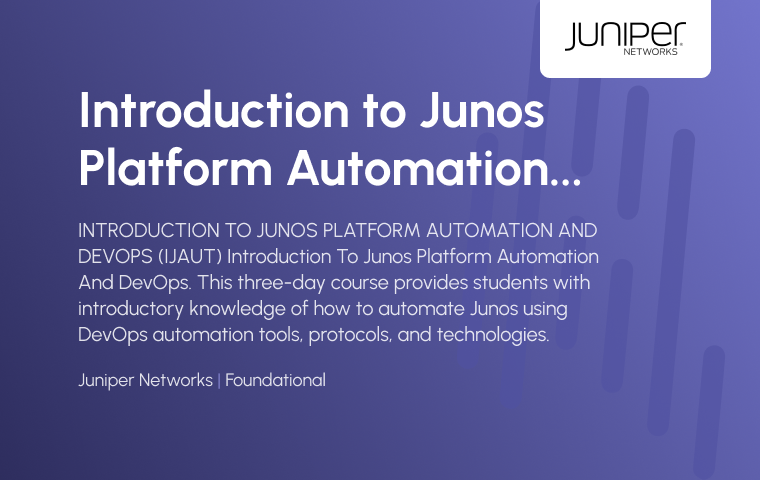
Introduction to Junos Platform Automation and DevOps (IJAUT)
This three-day course demonstrates how to automate the Junos OS using DevOps automation tools, protocols, and technologies. This course introduces basic DevOps principles, Junos APIs, and the Network Configuration Protocol (NETCONF). It focuses on using Python, Junos
PyEZ, Ansible, and the Junos Representational State Transfer (REST) API to automate Junos platforms. Extensible Markup Language (XML), JavaScript Object Notation (JSON), and YAML Ain’t Markup Languate (YAML) are introduced as data formats that facilitate Junos automation.
Through demonstrations and hands-on labs, students will gain experience automating the Junos operating system. This course uses Junos OS Release 20.2R2.11, Python 3.6.8, Junos PyEZ 2.54, and Ansible 2.9.5
Virtual Classroom Live
Prerequisites
• Basic understanding of the OSI model and the TCP/IP protocol suite;• Basic understanding of computer networking concepts.
Target Audience
What You’ll Learn
Course Outline
Labs Outline
Related Certifications
Describe DevOps principles and practices.
• Explain how DevOps benefits an IT organization.
• Discuss Network Reliability Engineering.
• List and describe the various APIs Junos provides for automation.
• Discuss the frameworks, libraries and tools used to automate Junos devices.
• Describe XML document format.
• Explain how the Junos OS uses XML.
• Use XPath to navigate a Junos XML document.
• Describe the NETCONF protocol.
• Use NETCONF and the XML API to issue Junos RPCs.
• List available XML API programming languages.
• Configure Junos device using NETCONF.
• Describe JSON syntax.
• Explain how JSON is used in Junos.
• Describe YAML syntax.
• Explain how Junos automation tools use YAML.
• Use JSON and YAML documents.
• Verify an Ansible installation.
• Retrieve information from Junos devices using Ansible.
• Use Ansible to configure Junos devices.
• Explain fundamental Python concepts.
• Use the Python 3 interactive interpreter.
• Modify and run Python scripts.
• Install Junos PyEZ.
• Use Junos PyEZ to connect to Junos devices and retrieve facts.
• Use Junos PyEZ to execute Junos RPCs.
• Use Junos PyEZ to modify Junos device configuration.
• Describe Python exception handling with PyEZ.
• Describe the capabilities of the Junos OS REST API.
• Generate REST API RPC queries.
• Use the REST API Explorer.
• Describe the Junos operating system and its basic design architecture.
• Explain transit and exception traffic processing.
• Describe the Junos CLI and its features.
• List and perform initial configuration tasks.
• Describe interface types and perform basic interface configuration tasks.
